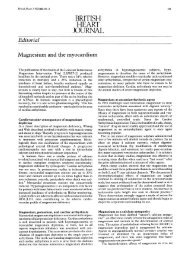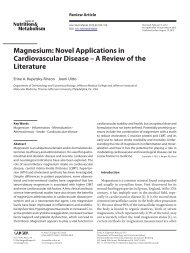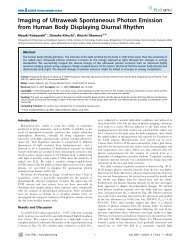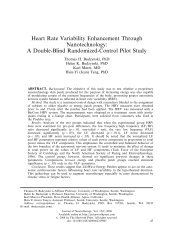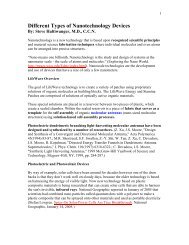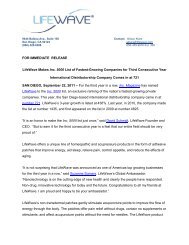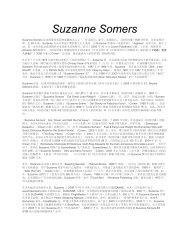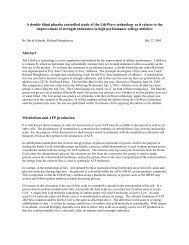Fenestra Research LifeWave Products
Fenestra Research LifeWave Products
Fenestra Research LifeWave Products
You also want an ePaper? Increase the reach of your titles
YUMPU automatically turns print PDFs into web optimized ePapers that Google loves.
<strong>Fenestra</strong> <strong>Research</strong><br />
<strong>LifeWave</strong> <strong>Products</strong><br />
Pure Energy Patches 60-Subject Test<br />
Final Report<br />
By <strong>Fenestra</strong> <strong>Research</strong><br />
Introduction<br />
<strong>LifeWave</strong> Patches are a non-invasive dermal patch worn on the human body.<br />
Rotation of placement of these patches was done on a daily base. Days of<br />
use and placement can be found in the attached files 1,2, and three. This<br />
6o- subject study was done without providing any kind of information to the<br />
subjects about the intended outcome or scope of this study. No educational<br />
material or advertisements were provided to the 60-subjects for the length<br />
of this study.<br />
Study Overview<br />
<strong>Fenestra</strong> <strong>Research</strong> preformed human Clinical Trials using this all-natural<br />
dermal patch system. This study involved 60-subjects of various , age,<br />
exercise levels, race, sex, and health levels. This study was conducted for<br />
30-days.<br />
Upon commencement of this study each subject was provide the correct<br />
amount of patches for their test group number to be used in pairs for 30-<br />
days. Each daily placement of the patches was done in pairs on the body<br />
with the white patch being secured in place on the right side of the body first<br />
and the tan patch placed on the left side of the body second.<br />
Subjects were advised that no changes to their daily lives should take place<br />
during this time. All subjects were instructed to make no changes to their<br />
daily food consumption in regards to the amount or the types of food they<br />
were consuming daily. No changes to the amount or type of water should be<br />
done for the length of this study. Instruction relating to water consumption<br />
were as follows; Each subject was to consume ½ of their weight in ounces<br />
daily of what ever source of water they usually consumed.<br />
2921 North Tenaya Way, Suite #222, Las Vegas, NV, 89128<br />
www.optimalwellnesstest.com
<strong>Fenestra</strong> <strong>Research</strong><br />
Compliance was monitored and maintained through bi-weekly phone calls.<br />
*See attachment for clinical overview procedures.<br />
Optimal Wellness Test Results after 30-days of Energy Patch Usage<br />
Upon completion of the 60-subject groups 30-day testing and intake these<br />
significant measurements were found:<br />
1. An increase of 22.3% was measured in the lipid side of the ATP cycle<br />
of energy production.<br />
2. 30% of subjects reported an increased since of well-being while<br />
wearing the patches.<br />
3. Daily wear of the patches did not have any reported negative side<br />
effects or interactions for the length of this study.<br />
4. At this time there are no significant changes to any of the other<br />
Wellness measurements being tested.<br />
5. Patches stayed in place all day for each of the participants with the<br />
exception of use in ocean water. Patches stayed on all day through<br />
showers, sweating and daily activities.<br />
6. No allergic reaction on or around the area of placements were seen or<br />
reported during this study.<br />
7. Five subjects reported a weight loss of at least 6 pounds during this<br />
study.<br />
8. 100% of these subjects tolerated the patch test well.<br />
2921 North Tenaya Way, Suite #222, Las Vegas, NV, 89128<br />
www.optimalwellnesstest.com
<strong>Fenestra</strong> <strong>Research</strong><br />
Conclusion<br />
We find that the daily use of the Energy Patches by <strong>LifeWave</strong> <strong>Products</strong> did<br />
improve the energy levels in 100% of our test subjects. This was<br />
proven using the <strong>Fenestra</strong> <strong>Research</strong> Labs Optimal Wellness Test, described<br />
in attachments. The Energy Patches are 100% safe and effective. Days of<br />
not wearing the patches were important to the overall usage and out come<br />
of this study.<br />
Additional Recommended Studies & <strong>Products</strong><br />
1. A long Phase 2, 6-month study of at least 30-subjects to evaluate the<br />
long term benefits of this product.<br />
2. The addition of Anabolic producing substances to be taken at night<br />
along with the Energy Patches may produce the positive usage<br />
reactions you are looking for in 100% of the users.<br />
2921 North Tenaya Way, Suite #222, Las Vegas, NV, 89128<br />
www.optimalwellnesstest.com
<strong>Fenestra</strong> <strong>Research</strong><br />
Human Clinical Trails Overview<br />
The <strong>Fenestra</strong> Terminology section defines the terms used to evaluate the<br />
degree of changes in the cellular body of test subjects.<br />
* Note ATP Energy Cycle percentage is a mathematical calculation derived<br />
from these measurements.<br />
pH: Acidity/Alkalinity<br />
The pH is a measurement of the concentration of hydrogen ions within the<br />
various body fluids. The lower the pH, the more acidic the solution;<br />
conversely, the higher the pH, the more alkaline the solution. The ph is<br />
measured on a logarithmic scale, meaning that for each charge of one pH<br />
unit, there is a tenfold change in the concentration of H+ ions in the fluids.<br />
The normal range for venous blood is 7.30 to 7.35. This slightly alkaline pH<br />
is due to the reservoir of bicarbonates ions in the blood that act as<br />
physiologic buffers and maintain the normal pH range. The perfect number<br />
for fasting urine and saliva is 6.4. These fluids tend to be more acid due to<br />
the removal of acid that is taking place in these body fluids.<br />
rH2 (Oxidation and Reduction)<br />
Oxidation is the combination of oxygen with other elements. In physiological<br />
terms, oxidation is defined as the gain of an oxygen molecule or the loss of a<br />
hydrogen particle (electron), during cellular respiration. Through a complex<br />
series of reactions ATP, the energy source for all biochemical processes in<br />
the body, is ultimately produced.<br />
This step-by-step removal of pairs of electrons from a substrate is the<br />
means by which food is converted into cellular energy. The end result of<br />
cellular respiration is the creation of energy (ATP), carbon dioxide, water and<br />
metabolic wastes.<br />
The rH2 value is a derived measurement. It is a calculation from the OPR<br />
(oxidation-reduction), the pH and the temperature of the fluid. The normal<br />
for urine is 22.5-24.5 and for saliva 21.5-23.5.<br />
2921 North Tenaya Way, Suite #222, Las Vegas, NV, 89128<br />
www.optimalwellnesstest.com
<strong>Fenestra</strong> <strong>Research</strong><br />
Brix<br />
The refractometer is an instrument that is used to relate the amount of<br />
refractive light in a liquid or a dissolved solid. The unit of measurement that<br />
the refractometer uses is call degrees Brix.<br />
The Brix number tells the amount of potential energy available. This<br />
potential energy is in the form of heat (calories) electro-magnetic related to<br />
pH and conductivity, and matter.<br />
If the Brix number falls below 1.2 the oxygen levels in the blood may be<br />
decreased and the body is not circulating enough oxygen. If the Brix number<br />
falls above 5.49 the oxygen levels may be higher than it needs to be,<br />
resulting in calcium absorption problems.<br />
Nitrate & Ammonium<br />
Both of these numbers influence the electromagnetic picture of the body<br />
fluids. Together they look at the amount of energy being lost from the<br />
system.<br />
Nitrate and ammonium are related to digestion, and they provide a look at<br />
the amount of usable energy being produced by digestion. The chemical<br />
reaction that takes place between food and digestive enzymes is vital to<br />
Wellness. The correct balance of water, calcium, and oxygen in the body is<br />
necessary for usable energy to be the result.<br />
The nitrate and ammonium particles are the result of poor digestion. The<br />
liver needs to make, energy so the liver incites the urea cycle to occur and<br />
cannot use amino acids that have not been digested properly.<br />
Another cause of ammonium production is bacterial metabolism in the<br />
intestinal lumen, thus released ammoniums are absorbed and transported to<br />
the liver. The liver treats the nitrates and ammoniums as toxins because the<br />
poor digestion has rendered the byproduct useable. This unusable material is<br />
converted into urea and stored in the body.<br />
Urea can only be stored for 72 hours before it becomes toxic, at that time<br />
the urea is broken down to urea salts of Nitrate and Ammonium Nitrogen.<br />
The numbers for perfect digestion are 3 nitrate and 3 for ammonium.<br />
2921 North Tenaya Way, Suite #222, Las Vegas, NV, 89128<br />
www.optimalwellnesstest.com
<strong>Fenestra</strong> <strong>Research</strong><br />
Toxicity<br />
The phrase "toxic" chemical is seen frequently in the media and heard often<br />
in social settings. Other than suggesting something bad about the chemical,<br />
what exactly is meant by saying that a chemical is toxic Does it mean that<br />
it will kill people Cause cancer Affect their children Are there chemicals<br />
that can't cause any harm To a toxicologist, this last question is easiest to<br />
answer. Everything is toxic: in sufficient quantities, every chemical has the<br />
capacity to cause adverse effects on human health. It is only the degree and<br />
type of toxicity that varies from chemical to chemical.<br />
Even chemicals that are necessary for life such as water and oxygen can be<br />
toxic. Human experience has shown that while usual amounts of oxygen and<br />
water don't cause adverse effects in humans, higher amounts can. Drinking<br />
very large amounts of water in a short period of time can lead to swelling<br />
and brain damage, particularly in infants. Breathing pure oxygen can also<br />
cause problems in humans, in this case irritation of the lungs. Thus, toxicity<br />
assessment is not about determining what is toxic, but rather about how<br />
much of a chemical causes what kind of harm.<br />
Dose-response studies are used to establish the relationship between the<br />
amount of chemical and the seriousness of the effect. The dose -- the actual<br />
amount of chemical -- is gradually increased and the responses -- the<br />
observed effects -- at each dose are noted. For some chemicals, such as<br />
some organophosphate pesticides, increasing the dose slightly leads to a<br />
large increase in effect (toxicity). Such a chemical doesn't have a large<br />
margin of safety and may be difficult to manage. On the other hand, the<br />
effects due to another chemical may increase only very slowly as the dose is<br />
increased. Such chemicals, such as alcohol, are easier to manage.<br />
Since toxicity refers to a number of possible adverse effects, there are<br />
several ways to deal with it. One-way is to divide the effects into categories<br />
based on two fundamental characteristics of toxicity: how fast the effects<br />
occur and what type they are. Effects that occur very rapidly after exposure<br />
has occurred are described as acute toxicity; those that happen only after<br />
repeated long-term exposure are known as chronic toxicity. Acute toxicity is<br />
the kind that people are familiar with from detective stories. For example,<br />
the victim drinks the poisoned wine and dies within minutes. Death is not<br />
the only type of acute effect, however; some others are sweating, nausea,<br />
and dizziness.<br />
2921 North Tenaya Way, Suite #222, Las Vegas, NV, 89128<br />
www.optimalwellnesstest.com
<strong>Fenestra</strong> <strong>Research</strong><br />
Chronic toxicity also may take many forms. The most well-known chronic<br />
effect is cancer. Others are organ damage such as cirrhosis of the liver from<br />
long-term alcohol consumption, reproductive effects such as decreased<br />
fertility, and effects on the nervous system. An example of a nervous system<br />
effect is mental retardation in children who were exposed to high levels of<br />
lead over a period of time in early childhood.<br />
Protein Digestion<br />
The importance of protease enzymes is directly related to protein digestion.<br />
This is an overriding issue in regards to <strong>Fenestra</strong> technological analysis.<br />
Proteases refer to a group of enzymes whose catalytic function is to<br />
hydrolyze (breakdown) proteins. They are also called proteolytic enzymes or<br />
proteinases.<br />
Proteolytic enzymes are very important in digestion as they breakdown the<br />
peptide bonds in the protein foods to liberate the amino acids needed by the<br />
body. Additionally, proteolytic enzymes have been used for a long time in<br />
various forms of therapy. Their use in medicine is notable based on several<br />
clinical studies indicating their benefits in oncology, inflammatory conditions,<br />
blood rheology control, and immune regulation. Protease is able to hydrolyze<br />
almost all proteins as long as they are not components of living cells.<br />
Normal living cells are protected against lysis by the inhibitor mechanism.<br />
Parasites, fungal forms, and bacteria are protein. Viruses are cell parasites<br />
consisting of nucleic acids covered by a protein film. Enzymes can break<br />
down undigested protein, cellular debris, and toxins in the blood, sparing the<br />
immune system this task. The immune system can then concentrate its full<br />
action on the bacterial or parasitic invasion.<br />
How Protease Deficiency Can Affect Your Health:<br />
Acidity is created through the digestion of protein. Therefore a protease<br />
deficiency results in alkaline excess in the blood. This alkaline environment<br />
can cause anxiety and insomnia.<br />
In addition, since protein is required to carry protein-bound calcium in the<br />
blood, a protease deficiency lays the foundation for arthritis, osteoporosis<br />
and other calcium-deficient diseases.<br />
Because protein is converted to glucose upon demand, inadequate protein<br />
digestion leads to hypoglycemia, resulting in moodiness, mood swings and<br />
2921 North Tenaya Way, Suite #222, Las Vegas, NV, 89128<br />
www.optimalwellnesstest.com
<strong>Fenestra</strong> <strong>Research</strong><br />
irritability.<br />
Protease also has an ability to digest unwanted debris in the blood including<br />
certain bacteria and viruses. Therefore, protease deficient people are<br />
immune compromised, making them susceptible to bacterial, viral and yeast<br />
infections and a general decrease in immunity.<br />
Carbohydrate Digestion<br />
One of the primary goals of the digestive process is to provide every body<br />
cell with sufficient amounts of energy to sustain itself and remain alive.<br />
Many of the vital chemical reactions that take place in the cell require<br />
energy, which is derived from the oxidation of the glucose, within the cell.<br />
Glucose is carried to the cell as the end product of carbohydrate metabolism.<br />
There, in the presence of enzymes and oxygen, the glucose is converted into<br />
carbon dioxide, water and energy. The carbon dioxide and water are nonessential<br />
by-products of this reaction; the important product is the heat<br />
energy, which is derived from the glucose.<br />
glucose + oxygen = carbon dioxide + water + heat<br />
(enzyme) (energy)<br />
The oxygen used in this chemical reaction is brought from the lungs to the<br />
cells by the red blood cells, containing hemoglobin. The hemoglobin and<br />
oxygen combine chemically until enzymes in the cell separate them for the<br />
oxidation process. Glucose is one of literally hundreds of chemical<br />
compounds called carbohydrates or saccharides. The molecules of all<br />
carbohydrates are made up of building blocks called simple sugars.<br />
Carbohydrates may be subdivided into three groups:<br />
Monosaccharides, like glucose, consist of a single sugar building block.<br />
Disaccharides, like common table sugar (sucrose) consist of two simple<br />
sugar building blocks.<br />
Polysaccharides, like starch and cellulose, consist of many simple sugar<br />
building blocks joined together in a long line in daisy-chain fashion.<br />
It appears that the only carbohydrate of any chemical value to the body is<br />
the simple sugar or monosaccharide called glucose. Therefore, one of the<br />
major goals of the digestive process is to extract the glucose from the<br />
various carbohydrates that we ingest every day. Carbohydrate sources are<br />
primarily starches (like grains) and sugars (like cane sugar, milk sugar, fruit<br />
sugar). The enzyme ptyalin or amylase in the saliva begins to break down<br />
the food in the mouth. Food does not stay in the mouth long enough for<br />
2921 North Tenaya Way, Suite #222, Las Vegas, NV, 89128<br />
www.optimalwellnesstest.com
<strong>Fenestra</strong> <strong>Research</strong><br />
ptyalin to complete the breakdown of starches. Yet the action of ptyalin<br />
continues for several hours after food has entered the stomach...until the<br />
food is mixed with the stomach secretions. Once the pH of the food's<br />
environment falls below approximately 4.0, as will occur in the second<br />
portion of the stomach, this enzyme becomes non-active. But, before this<br />
happens, 30 to 40 percent of the starches will have been changed into<br />
maltose and isomaltose. They are now ready to enter the small intestine as<br />
part of the chyme. When muscle tone and other factors are normal, the<br />
result is a beautifully timed and regulated pumping. With each strong wave<br />
of movement, several milliliters of chyme are forced from the stomach into<br />
the duodenum. This stomach and intestinal reflex is especially sensitive to<br />
the presence of irritants, breakdown products of protein digestion, proper<br />
concentration of fluid and to substances too acid or too alkaline.<br />
As covered previously, this emphasizes the need for sufficient hydrochloric<br />
acid and other gastric secretions, the importance of drinking water before<br />
eating and the avoidance of antacids or other drugs that would interfere with<br />
or halt digestion. As much as 30 to 40 percent of starches have been<br />
changed (broken down) into maltose and isomaltose (combinations of simple<br />
sugars) before reaching the small intestine. After the chyme enters the<br />
duodenum and mixes with pancreatic juice, starches, not yet split, are<br />
immediately digested by amylase. Like saliva, pancreatic secretions contain<br />
large amounts of amylase, acting identically to the amylase in saliva,<br />
splitting the starches into maltose and isomaltose. Carbohydrate, split down<br />
into simple sugar combinations (disaccharides), lactose, sucrose, maltose<br />
and isomaltose, are then split even further into just simple sugars<br />
(monosaccharides) by enzymes from the cells lining the small intestine.<br />
These simple sugars (galactose, glucose, fructose) are then absorbed into<br />
portal blood...that is, on their way to the liver. About 80 percent of the final<br />
products of carbohydrate digestion is glucose. Blood sugar is glucose.<br />
2921 North Tenaya Way, Suite #222, Las Vegas, NV, 89128<br />
www.optimalwellnesstest.com
<strong>Fenestra</strong> <strong>Research</strong><br />
Cellular Respiration<br />
The series of metabolic processes by which living cells produce energy<br />
through the oxidation of organic substances<br />
We all need energy to function. We get this energy from the foods we eat.<br />
The most efficient way for cells to harvest energy stored in food is through<br />
cellular respiration, a catabolic pathway for the production of adenosine<br />
triphosphate (ATP). ATP, a high-energy molecule, is expended by working<br />
cells. Cellular respiration has three main stages: glycolysis, the citric acid cycle, and electron<br />
transport.<br />
Glycolysis: Glycolysis literally means "splitting sugars." Glucose, a six-carbon<br />
sugar, is split into two molecules of a three carbon sugar. In the process,<br />
two molecules of ATP and two "high energy" electron carrying molecules are<br />
produced. Glycolysis can occur with or without oxygen. In the presence of<br />
oxygen, glycolysis is the first stage of cellular respiration. Without oxygen,<br />
glycolysis allows cells to make small amounts of ATP. This process is called<br />
fermentation.<br />
The Citric Acid Cycle: The Citric Acid Cycle or Krebs Cycle begins after the<br />
two molecules of the three carbon sugar produced in glycolysis are<br />
converted to a slightly different compound (acetyl CoA). Through a series of<br />
intermediate steps, several compounds capable of storing "high energy"<br />
electrons are produced along with two ATP molecules. These compounds,<br />
known as nicotinamide adenine dinucleotide (NAD) and flavin adenine<br />
dinucleotide (FAD), are reduced in the process. These reduced forms carry<br />
the "high energy" electrons to the next stage. The Citric Acid Cycle occurs<br />
only when oxygen is present but it doesn't use oxygen directly.<br />
Electron Transport: Electron Transport requires oxygen directly. The electron<br />
transport "chain" is a series of electron carriers in the membrane of the<br />
mitochondria. Through a series of reactions, the "high energy" electrons are<br />
passed to oxygen. In the process, a gradient is formed, and ultimately ATP is<br />
produced.<br />
Renal (Kidney) Function<br />
Balance is based on ability of the kidneys to excrete wastes and to help<br />
maintain the electrolyte balance.<br />
Acute renal failure (ARF) is the sudden loss of kidney function. It occurs<br />
when the kidneys stop working over a period of hours, days, or in some<br />
2921 North Tenaya Way, Suite #222, Las Vegas, NV, 89128<br />
www.optimalwellnesstest.com
<strong>Fenestra</strong> <strong>Research</strong><br />
cases, weeks. When ARF occurs, waste products, such as nitrogen, and<br />
excess fluids are not removed by the kidneys and build up in the body,<br />
upsetting the body's normal chemical balance. Chemicals and electrolytes,<br />
such as sodium, potassium, and calcium, which are needed for normal body<br />
functioning, become poisonous (toxic) to the body when they reach<br />
abnormally high levels.<br />
Decreased blood flow -- this may occur when there is extremely low blood<br />
pressure caused by trauma, complicated surgery, septic shock, hemorrhage,<br />
or burns; associated dehydration; or other severe or complicated illnesses.<br />
Acute tubular necrosis (ATN) -- may occur when tissues aren't getting<br />
enough oxygen or when the renal artery is blocked or narrowed (see acute<br />
arterial occlusion of the kidney and renal artery stenosis).<br />
Over-exposure to metals, solvents, radiographic contrast materials, certain<br />
antibiotics, and other medications or substances.<br />
Myoglobinuria (myoglobin in the urine) -- this condition may be caused by<br />
rhabdomyolysis, alcohol abuse, a crush injury, tissue death of muscles from<br />
any cause, seizures, and other disorders.<br />
Direct injury to the kidney.<br />
Infections such as acute pyelonephritis or septicemia.<br />
Urinary tract obstruction, such as a narrowing of the urinary tract (stricture),<br />
tumors, kidney stones, nephrocalcinosis or enlarged prostate with<br />
subsequent acute bilateral obstructive uropathy.<br />
Severe acute nephritic syndrome.<br />
Disorders of the blood, such as idiopathic thrombocytopenic purpura (ITP),<br />
transfusion reaction, or other hemolytic disorders, malignant hypertension<br />
and disorders resulting from childbirth, such as bleeding placenta abruptio or<br />
placenta previa can damage the kidneys.<br />
Autoimmune disorders such as scleroderma can cause acute renal failure.<br />
In young children, hemolytic uremic syndrome is an increasingly common<br />
cause of acute renal failure. A toxin-secreting bacterium, Escherichia coli,<br />
found in contaminated undercooked meats, has been implicated as the cause<br />
of hemolytic uremic syndrome.<br />
Hepatic Function<br />
2921 North Tenaya Way, Suite #222, Las Vegas, NV, 89128<br />
www.optimalwellnesstest.com
<strong>Fenestra</strong> <strong>Research</strong><br />
Hepatic pertains to liver.<br />
Hepatic encephalopathy is a syndrome seen in patients with cirrhosis of the<br />
liver. Personality changes, intellectual impairment, and a depressed level of<br />
consciousness, fluctuating neurologic signs, asterixis or “flapping tremor,”<br />
and distinctive electroencephalographic changes characterize it. An<br />
important prerequisite for the syndrome is diversion of portal blood into the<br />
systemic circulation through porto-systemic collateral vessels. Indeed,<br />
hepatic encephalopathy may develop in non-cirrhotic patients who have<br />
undergone portocaval shunt surgery. The development of hepatic<br />
encephalopathy is explained to some extent by the effect of neurotoxic<br />
substances, which occurs in the setting of cirrhosis and portal hypertension.<br />
Subtle signs of hepatic encephalopathy are seen in nearly 70% of patients<br />
with cirrhosis. Symptoms may be debilitating in a significant number of<br />
patients and are seen in 24-53% of patients who undergo portosystemic<br />
shunt surgery. About 30% patients dying of end-stage liver disease will<br />
experience significant encephalopathy, approaching coma.<br />
Encephalopathy may be acute and reversible or chronic and progressive. In<br />
severe cases, irreversible coma and death may occur. Acute episodes may<br />
recur with variable frequency<br />
Hepatic encephalopathy, accompanied with severe dysfunction of the hepatic<br />
synthetic activity is also the hallmark of fulminant hepatic failure (FHF).<br />
Symptoms of encephalopathy in FHF are graded using the same scale<br />
employed to assess encephalopathy symptoms in cirrhosis. However, the<br />
pathogenesis of the encephalopathy in FHF differs from that of cirrhosis. In<br />
FHF, altered mental function is attributed to increased permeability of the<br />
blood-brain barrier and to impaired osmoregulation within the brain. The<br />
resulting brain cell swelling and brain edema is potentially fatal. In contrast,<br />
brain edema is rarely reported in cirrhosis.<br />
2921 North Tenaya Way, Suite #222, Las Vegas, NV, 89128<br />
www.optimalwellnesstest.com
<strong>Fenestra</strong> <strong>Research</strong><br />
Oxidative Stress<br />
A condition of increased oxidant production in animal cells characterized by<br />
the release of free radicals and resulting in cellular degeneration.<br />
Free radicals such as reactive oxygen species are formed during a variety of<br />
biochemical reactions and cellular functions (such as mitochondria<br />
metabolism). The steady-state formation of pro-oxidants (free radicals) is<br />
normally balanced by a similar rate of consumption by antioxidants.<br />
Oxidative stress results from an imbalance between formation and<br />
neutralization of pro-oxidants. Various pathologic processes disrupt this<br />
balance by increasing the formation of free radicals in proportion to the<br />
available antioxidants (thus, oxidative stress). Examples of increased free<br />
radical formation are immune cell activation, inflammation, ischemia,<br />
infection, cancer and so on. Free radical formation and the effect of these<br />
toxic molecules on cell function (which can result in cell death) are<br />
collectively called "oxidative stress." These free radicals are highly reactive,<br />
unstable molecules that have an unpaired electron in their outer shell. They<br />
react with (oxidize) various cellular components including DNA, proteins,<br />
lipids / fatty acids and advanced glycation end products (e.g. carbonyls).<br />
These reactions between cellular components and free radicals lead to DNA<br />
damage, mitochondrial malfunction, cell membrane damage and eventually<br />
cell death (apoptosis - which is the term for programmed cell death).<br />
Redox Potential<br />
The redox potential is a measure (in volts) of the affinity of a substance for<br />
electrons — its electronegativity — compared with hydrogen (which is set at<br />
0). Substances more strongly electronegative than (i.e., capable of<br />
oxidizing) hydrogen have positive redox potentials. Substances less<br />
electronegative than (i.e., capable of reducing) hydrogen have negative<br />
redox potentials. Oxidations and reductions always go together. They are<br />
called redox reactions. When electrons flow "downhill" in a redox reaction,<br />
they release free energy.<br />
Redox potentials are present for every substance that undergoes a chemical<br />
reaction including enzymes and body fuel sources such as starches, sugars,<br />
fats, and proteins. A molecule is the smallest unit of any given substance<br />
(compound)- it in turn is made up of individual atoms. Individual atoms are<br />
made up of protons, neutrons and electrons. Molecules of glucose, starches,<br />
2921 North Tenaya Way, Suite #222, Las Vegas, NV, 89128<br />
www.optimalwellnesstest.com
<strong>Fenestra</strong> <strong>Research</strong><br />
and other sugars (containing atoms of carbon, hydrogen, and oxygen) are<br />
broken down to an intermediary compound called acetyl-CoA, which in turn<br />
stripped of electrons in the presence of oxygen ("oxidized") to produce ATP<br />
(energy), carbon dioxide and water.<br />
Just about anything that is synthesized (made) or metabolized (broken<br />
down) has a redox potential. The redox (energy) potential of a chemical<br />
reaction does not change. For example, the amount of energy released by<br />
the aerobic metabolism (oxidative) of a single molecule of glucose will<br />
always be the same.<br />
By Melonie Montgomery M.S.H.N.<br />
2921 North Tenaya Way, Suite #222, Las Vegas, NV, 89128<br />
www.optimalwellnesstest.com
<strong>Fenestra</strong> <strong>Research</strong><br />
Hydration<br />
There are four <strong>Fenestra</strong> parameters used to determine overall hydration:<br />
Conductance<br />
Resistivity<br />
Surface Tension<br />
Specific Gravity<br />
Although the precise mathematical formula used to determine hydration<br />
wellness is proprietary to the <strong>Fenestra</strong> Corporation, the four parameters can<br />
be reviewed to make sense out this measurement approach. In order to<br />
measure the four components that allow for a hydration computation it is<br />
necessary to analyze fluids from the body in the form of some or all of<br />
saliva, blood and urine. By doing so a specific numerical representation can<br />
be derived for the four parameters involved coming up with the final<br />
hydration Wellness number.<br />
The foundation of considering the electrical properties in the <strong>Fenestra</strong><br />
technology is the basic formula C = R/V, which is called Ohm’s Law. Through<br />
the interplay of voltage with both Conductivity and Resistivity some basic<br />
knowledge about intra and extra cellular hydration can be accessed.<br />
Conductivity is related to intracellular hydration and Resistivity is related to<br />
extracellular hydration. With the fluid samples obtained from each person in<br />
the <strong>LifeWave</strong> <strong>Products</strong> two of the four parameters can be measured.<br />
The other two parameters have more to do with chemical content but to<br />
some extent still related to electrical properties of body fluids. As indicated<br />
in the terminology definitions in this section surface tension is directly<br />
related to inward molecular attraction, with the obvious implication that if<br />
solids are suspended properly via molecular combinations with H20 then this<br />
means that the fluids of the body that surface will have lower surface<br />
tension. Specific gravity of any given bodily fluid reveals the content of<br />
solids in solution, with higher and higher concentrations of solids –both intra<br />
and extra cellular – raising the specific gravity number as a possible<br />
indicator of dehydration.<br />
Conductivity<br />
Conductivity is a measurement of the amount and quality of electrical<br />
current in the body.<br />
2921 North Tenaya Way, Suite #222, Las Vegas, NV, 89128<br />
www.optimalwellnesstest.com
<strong>Fenestra</strong> <strong>Research</strong><br />
Toxicity is a measurement of salts in the body. Salts are electrolytes and<br />
they are responsible for the electrical conduction of information in the body.<br />
Conductivity looks at the measurement of the quantity of current flow within<br />
the biological specimen and is an indicator of osmotic pressure, heat loss,<br />
and fluid balance.<br />
If the current in the body is too high or too low there will be symptoms of<br />
degeneration of the body.<br />
Resistivity<br />
Resistivity reflects the flow of ions across cellular membranes.<br />
The resistivity is the measurement of the relative concentrations of minerals<br />
contained within the test samples. The slight difference in the concentration<br />
of minerals found in the plasma vs. the amount found inside the cells creates<br />
a voltage gradient called the membrane potential. Therefore, resistivity is a<br />
direct reflection of the body’s ability to conduct electrical currents.<br />
Minerals are also essential co-factors for enzymes. A lock-and-key<br />
mechanism occurs between an enzyme and a mineral to activate the<br />
enzymes and cause it to perform its biochemical functions. When minerals<br />
are too low or deficient, enzymatic reactions may occur poorly.<br />
Surface Tension<br />
As biological phenomena the surface tension of fluids in the body can be<br />
compared through technological analysis with that of pure water. Higher<br />
surface tension implies a decreased capacity for cellular permeability for any<br />
given fluid.<br />
Surface tension of a fluid can be defined as inward molecular attraction<br />
forces, which must be overcome to increase the surface area. Surface<br />
tension is the energy required to increase the surface area of a liquid by a<br />
unit amount.<br />
In water the intermolecular hydrogen bonds are involved in the inward<br />
attraction forces. The surface tension of water at 20 degrees centigrade is<br />
7.29 x 10 -2 J/m 2 .<br />
2921 North Tenaya Way, Suite #222, Las Vegas, NV, 89128<br />
www.optimalwellnesstest.com
<strong>Fenestra</strong> <strong>Research</strong><br />
Specific Gravity<br />
From a mathematical point of view specific gravity is very similar to density.<br />
Specific gravity is defined as density of a substance divided by the density of<br />
water. Since the units will cancel out in any computation it simply means<br />
that the only difference between specific gravity and density is that the there<br />
are no units associated with specific gravity as is the case with density.<br />
With bodily fluids density is a function of the types and amounts of solids<br />
found in solution. The more there is of substances in solution that are<br />
heavier than water the higher the density will be. With dehydration, whether<br />
it is intra or extra cellular, the density of fluids will be higher because the<br />
water content goes down as the solids go up. The converse is true for<br />
increased hydration.<br />
Comments about the Interplay of all Four Hydration Parameters<br />
It might be assumed that the four properties of fluids as measured with the<br />
four different <strong>Fenestra</strong> tests are much better if they go farther and farther<br />
into higher and lower ranges. But the uniqueness of the <strong>Fenestra</strong> technology<br />
is that the testing and computation process is all built into the hardware and<br />
software. It works with the interface of different parameters to extract<br />
specific evaluations, as is the case with different levels of hydration and how<br />
this changes over time with any given modality. The key is balance for any<br />
given parameter in terms of the interplay with other parameters in revealing<br />
whether or not there is an increase or decrease in Wellness.<br />
Part Two<br />
Other <strong>Fenestra</strong> Parameters<br />
As I indicate in the introduction, the following parameters that can be<br />
obtained with <strong>Fenestra</strong> testing are not truly amenable for a 30 day clinical<br />
study. A long term 6 month study is being planned for the 2005 at the end<br />
of the first quarter to study the effects of drinking Glacia Nova Pure Glacial<br />
Water.<br />
2921 North Tenaya Way, Suite #222, Las Vegas, NV, 89128<br />
www.optimalwellnesstest.com



